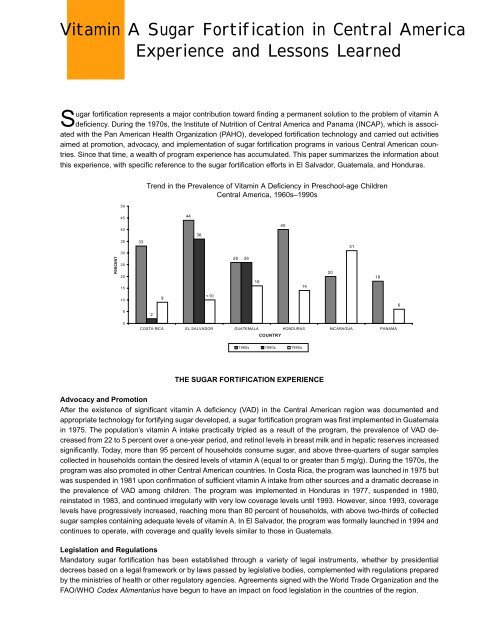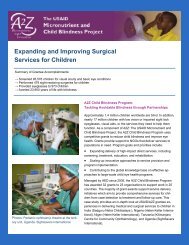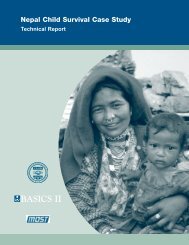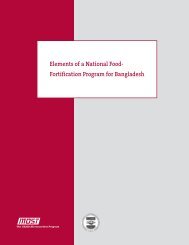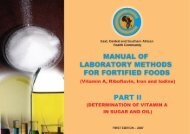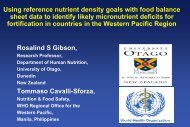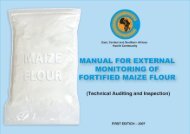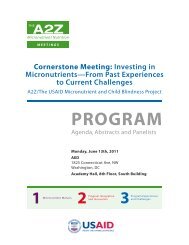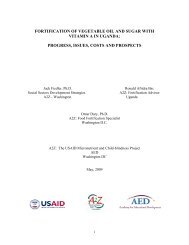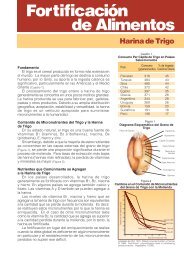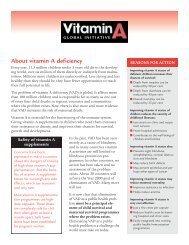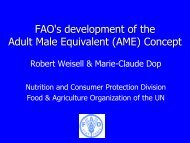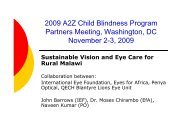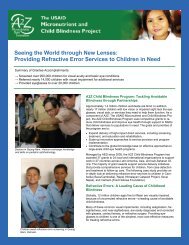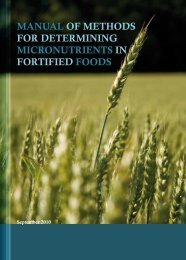Vitamin A Sugar Fortification in Central America - A2Z: The USAID ...
Vitamin A Sugar Fortification in Central America - A2Z: The USAID ...
Vitamin A Sugar Fortification in Central America - A2Z: The USAID ...
- No tags were found...
Create successful ePaper yourself
Turn your PDF publications into a flip-book with our unique Google optimized e-Paper software.
<strong>Vitam<strong>in</strong></strong> A <strong>Sugar</strong> <strong>Fortification</strong> <strong>in</strong> <strong>Central</strong> <strong>America</strong>Experience and Lessons Learned<strong>Sugar</strong> fortification represents a major contribution toward f<strong>in</strong>d<strong>in</strong>g a permanent solution to the problem of vitam<strong>in</strong> Adeficiency. Dur<strong>in</strong>g the 1970s, the Institute of Nutrition of <strong>Central</strong> <strong>America</strong> and Panama (INCAP), which is associatedwith the Pan <strong>America</strong>n Health Organization (PAHO), developed fortification technology and carried out activitiesaimed at promotion, advocacy, and implementation of sugar fortification programs <strong>in</strong> various <strong>Central</strong> <strong>America</strong>n countries.S<strong>in</strong>ce that time, a wealth of program experience has accumulated. This paper summarizes the <strong>in</strong>formation aboutthis experience, with specific reference to the sugar fortification efforts <strong>in</strong> El Salvador, Guatemala, and Honduras.50Trend <strong>in</strong> the Prevalence of <strong>Vitam<strong>in</strong></strong> A Deficiency <strong>in</strong> Preschool-age Children<strong>Central</strong> <strong>America</strong>, 1960s–1990s4544PERCENT4035302520153336262616401420311810529
Technological Development<strong>Fortification</strong> technology <strong>in</strong>volves the preparation of a vitam<strong>in</strong> A-sugar premix, which is then added to sugar at theref<strong>in</strong>eries. Initially, this process was carried out manually by load<strong>in</strong>g the needed amount of premix <strong>in</strong>side the centrifugewhere sugar is separated from the molasses. However, the progressive automation of sugar process<strong>in</strong>g s<strong>in</strong>ce 1987 hasrequired the use of mechanical dosifiers, which created problems with respect to the accurate amount of premix to addand the homogenous blend<strong>in</strong>g of premix with<strong>in</strong> the product. It was also observed that some vitam<strong>in</strong> A is lost <strong>in</strong> thedry<strong>in</strong>g process. To solve these problems, mechanical dosifiers equipped with a variable flow mechanism and a mix<strong>in</strong>gsystem that guarantees uniform blend<strong>in</strong>g of premix throughout the product are currently be<strong>in</strong>g tested. In addition, newfortify<strong>in</strong>g compound formulas with greater stability and different methods for attach<strong>in</strong>g vitam<strong>in</strong> A to sugar crystals arebe<strong>in</strong>g developed.Quality Assurance and ControlDevelopment and test<strong>in</strong>g of a quality assurance system was carried out <strong>in</strong> Honduras and subsequently transferred tothe other countries <strong>in</strong> the region. <strong>The</strong> system, which was f<strong>in</strong>ally implemented on a permanent basis <strong>in</strong> 1995, consistsessentially of a quality control and assurance process for fortified sugar by producers and the <strong>in</strong>spection and monitor<strong>in</strong>gof sugar quality at production centers and retail locations by the Department of Food Control of the M<strong>in</strong>istry of Health.In Honduras, the system has proven to be effective <strong>in</strong> improv<strong>in</strong>g fortified sugar quality and coverage levels. <strong>The</strong> keyelements of the system have been cont<strong>in</strong>uous quality assurance by producers, periodic government <strong>in</strong>spections, the<strong>in</strong>troduction of product label<strong>in</strong>g, and the analysis of the vitam<strong>in</strong> A content <strong>in</strong> household sugar samples, collected throughmultipurpose annual surveys.Program Monitor<strong>in</strong>g and EvaluationA monitor<strong>in</strong>g and evaluation system has been useful <strong>in</strong> determ<strong>in</strong><strong>in</strong>g the extent to which a population is covered and theprogram quality at the consumer level. Epidemiological surveillance has been carried out through national surveys <strong>in</strong>order to evaluate the program’s biological effects. Results <strong>in</strong>dicate that significant quantities of vitam<strong>in</strong> A are receivedby the population through sugar consumption, which constitutes the ma<strong>in</strong> dietary source of the vitam<strong>in</strong>. In 1995, fortifiedsugar was the source of approximately half of the vitam<strong>in</strong> A <strong>in</strong>take of Guatemalan children between two and five yearsof age. National surveys conducted between 1995 and 1998 <strong>in</strong> the three countries demonstrated a significant reduction<strong>in</strong> VAD among preschool-aged children with respect to earlier surveys. However, the program has had less of an impacton under-two children, possibly because this group consumes less sugar.Cost Analysis<strong>The</strong> total annual cost of the program per 100,000 metric tons (MT) amount to US$940,125 or $9.40 per MT, of which 98percent (US$918,125) is covered by the sugar <strong>in</strong>dustry and passed on to consumers, while the rema<strong>in</strong><strong>in</strong>g 2 percent(US$22,000) is assumed by the government. Dur<strong>in</strong>g the 1998–99 harvest, approximately 700,000 MT of sugar werefortified <strong>in</strong> the three countries studied, serv<strong>in</strong>g a total population of 24 million <strong>in</strong>habitants. In terms of annual costs, thisrepresents a total cost of US$6.58 million; a per capita cost of US$0.27; a cost of US$0.30 per person covered; a costof US$0.51 per high-risk person covered; and a cost of US$0.76 per vulnerable high-risk person covered.LESSONS LEARNED<strong>The</strong> <strong>Central</strong> <strong>America</strong>n Context<strong>The</strong> experience ga<strong>in</strong>ed from sugar fortification <strong>in</strong> <strong>Central</strong> <strong>America</strong> should be exam<strong>in</strong>ed with<strong>in</strong> the specific context of thethree relatively small countries studied. <strong>The</strong> poor <strong>in</strong> these countries represent between two-thirds and three-quarters ofthe total population. Between 1960 and 1997, the countries achieved reductions <strong>in</strong> their <strong>in</strong>fant and child mortality ratesof between 70 and 80 percent. All three countries have democratic systems of government. However, the public sector<strong>in</strong> each is limited <strong>in</strong> its capacity and efficiency to set standards and monitor compliance with legislation, as opposed tothe better-organized and responsive private sector. <strong>Sugar</strong> production <strong>in</strong> the three countries constitutes one of the mostactive <strong>in</strong>dustries of the economy; it is essentially a private sector activity, with a relatively small number of easilyaccessible ref<strong>in</strong>eries set up <strong>in</strong> strategic locations. <strong>Sugar</strong> production <strong>in</strong> all three countries is sufficient to meet domesticdemand, and between one- and two-thirds of production is exported. <strong>Sugar</strong> is consumed by most (>90 percent) of thepopulation, from all socioeconomic strata. Initially, fortification costs were covered by producers, but were later passedon to consumers as part of <strong>in</strong>flationary price <strong>in</strong>creases.
Advocacy and Promotion1. <strong>The</strong> start<strong>in</strong>g po<strong>in</strong>t <strong>in</strong> develop<strong>in</strong>g a food fortification program with public health objectives is thorough documentationof nutritional deficiency to establish the scope, severity, distribution, and characteristics of the problem.2. <strong>The</strong> widespread dissem<strong>in</strong>ation of <strong>in</strong>formation—regard<strong>in</strong>g vitam<strong>in</strong> A deficiency, its implications for health and thecountry’s social development, the analysis of alternative <strong>in</strong>terventions, the advantages of fortification, and how toidentify fortified products—is an essential element <strong>in</strong> sensitization, advocacy, and program development.3. <strong>The</strong> presence of an <strong>in</strong>stitution with the capacity to br<strong>in</strong>g the <strong>in</strong>volved actors together can help establish and ma<strong>in</strong>ta<strong>in</strong>food fortification and other nutrition programs.4. <strong>The</strong> participation of producers <strong>in</strong> a program from its early plann<strong>in</strong>g stage is necessary <strong>in</strong> order to enlist the <strong>in</strong>dustry’ssupport for and commitment to these programs by establish<strong>in</strong>g a mutually reward<strong>in</strong>g public/private partnership.Legislation and Regulations5. Adequate legal or statutory <strong>in</strong>struments—<strong>in</strong>clud<strong>in</strong>g a fortification law, standards of identity, technical regulations,and universal label<strong>in</strong>g—should be <strong>in</strong> place to support sugar fortification.6. <strong>The</strong> establishment of legal criteria regard<strong>in</strong>g the nutrient content of the fortificant <strong>in</strong> terms of a m<strong>in</strong>imum acceptablelevel for the consumer is preferable to establish<strong>in</strong>g criteria to govern the production process.7. <strong>The</strong> harmonization of legislative <strong>in</strong>struments and technical regulations among neighbor<strong>in</strong>g countries is importantto satisfy free trade <strong>in</strong>itiatives and agreements.8. Given the limited stability of vitam<strong>in</strong> A <strong>in</strong> the <strong>in</strong>dustrial process<strong>in</strong>g of some soft dr<strong>in</strong>ks, the sugar used <strong>in</strong> theproduction of such soft dr<strong>in</strong>ks can be exempted from mandatory fortification.Technological Development9. <strong>The</strong> level of vitam<strong>in</strong> A fortificant should be established based upon per capita sugar consumption and the size ofthe vitam<strong>in</strong> A <strong>in</strong>take gap <strong>in</strong> the population.10. Both producers and governments should be kept abreast of advances made <strong>in</strong> the development of more stablefortify<strong>in</strong>g compounds and better techniques for add<strong>in</strong>g premix <strong>in</strong> order to <strong>in</strong>corporate program changes <strong>in</strong> a timelymanner.Quality Assurance and Control11. It is crucial for governments to adopt a positive and collaborative attitude toward producers—<strong>in</strong>stead of a repressiveand punitive regulatory disposition—and for producers to assume responsibility for conscientiously ensur<strong>in</strong>gthe quality and control of their products.12. Depend<strong>in</strong>g on the local <strong>in</strong>dustry’s level of development, it may be necessary for governments to provide tra<strong>in</strong><strong>in</strong>gand guidance <strong>in</strong> quality assurance to ref<strong>in</strong>eries, especially dur<strong>in</strong>g the <strong>in</strong>itial program stages.13. <strong>The</strong> governmental entity responsible for the fortification program may need to design and implement a formalplan for external audit<strong>in</strong>g at the central level, which may gradually shift emphasis from production plants to retailoutlets.Monitor<strong>in</strong>g and Evaluation14. Program monitor<strong>in</strong>g and evaluation activities can be strengthened at low cost by assess<strong>in</strong>g levels of vitam<strong>in</strong> A <strong>in</strong>sugar dur<strong>in</strong>g other, scheduled household surveys.15. <strong>The</strong> development of practical, low-cost epidemiological micronutrient surveillance systems is needed to facilitateboth program monitor<strong>in</strong>g and impact evaluation.16. Under-two children and other groups that may not be fully covered by the program because they do not consumesufficient sugar on a regular basis should be targeted for periodic supplementation.Cost Analysis17. To a large extent, the economic feasibility of fortification depends on whether producers are sufficiently motivatedand will<strong>in</strong>g to make the <strong>in</strong>itial <strong>in</strong>vestment <strong>in</strong> necessary equipment, facilities, and <strong>in</strong>puts, which can be passed onto consumers as part of <strong>in</strong>flationary price <strong>in</strong>creases.
18. <strong>The</strong> government can help facilitate the <strong>in</strong>itial first-year capital <strong>in</strong>vestment by act<strong>in</strong>g as the <strong>in</strong>dustry’s guarantor onf<strong>in</strong>anc<strong>in</strong>g applications.19. Start-up costs can be reduced by adapt<strong>in</strong>g exist<strong>in</strong>g facilities for use as premix process<strong>in</strong>g plants, donation ofequipment used <strong>in</strong> premix preparation, or the use of exist<strong>in</strong>g laboratory equipment at ref<strong>in</strong>eries.Susta<strong>in</strong>ability of SupplyF<strong>in</strong>ancial Susta<strong>in</strong>ability20. It is important that external cooperation agencies concentrate their f<strong>in</strong>ancial support <strong>in</strong> technological developmentand the design and implementation of policies and programs rather than <strong>in</strong> assum<strong>in</strong>g operat<strong>in</strong>g costs for thesystem of <strong>in</strong>spection and monitor<strong>in</strong>g.Institutional Capacity21. A governmental unit with adequate managerial and logistic capability, and charged with specific responsibility forprogram coord<strong>in</strong>ation and management, is essential for a well-function<strong>in</strong>g program.22. Research and development organizations at the regional level and national associations/groups can play animportant role <strong>in</strong> provid<strong>in</strong>g technical assistance to strengthen <strong>in</strong>stitutional capacity.23. Human resources development and periodic retra<strong>in</strong><strong>in</strong>g are essential <strong>in</strong>stitutional-strengthen<strong>in</strong>g activities.Political Environment24. A solid political commitment of both the government and the <strong>in</strong>dustry and an effective policy development andimplementation process are key elements for ensur<strong>in</strong>g long-term susta<strong>in</strong>ability of fortification programs.25. <strong>The</strong> political susta<strong>in</strong>ability of fortification programs is strengthened by the creation and effective operation of amultisectoral committee or commission.26. Regional research and development <strong>in</strong>stitutions <strong>in</strong> the field of nutrition and external cooperation agencies can playa critical role <strong>in</strong> ma<strong>in</strong>ta<strong>in</strong><strong>in</strong>g communication and dialog <strong>in</strong> order to ensure the stability of the political commitmentto sugar fortification.27. It is essential that the government abide by its commitments to the private sector <strong>in</strong> order to promote the level ofconfidence necessary to ensure the political susta<strong>in</strong>ability of the program.28. Appropriate fortification technology and compatibility between the capacity of exist<strong>in</strong>g technology to achieve certa<strong>in</strong>quality results and the technical specifications established by the government are needed to ensure a solid<strong>in</strong>dustry commitment.29. Re<strong>in</strong>forc<strong>in</strong>g policy decision mak<strong>in</strong>g with<strong>in</strong> the government and the <strong>in</strong>dustry requires long-term, ongo<strong>in</strong>g efforts <strong>in</strong>promotion and advocacy <strong>in</strong> key areas.Susta<strong>in</strong>ability of Demand30. Information media are key to ensur<strong>in</strong>g that consumers are fully <strong>in</strong>formed and aware of the importance of fortification<strong>in</strong> health and nutrition, can identify the fortified foodstuff, and, if needed, can eventually take part <strong>in</strong> socialmobilization <strong>in</strong> support of the program.<strong>The</strong> full document on which this summary is based can be found on the MOST Web site, www.mostproject.org.Requests for hard copies should be sent to most@isti<strong>in</strong>c.com or MOST, International Science and TechnologyInstitute, Inc., 1820 N. Fort Myer Drive, Suite 600, Arl<strong>in</strong>gton, VA 22209.<strong>The</strong> <strong>USAID</strong> Micronutrient Program


